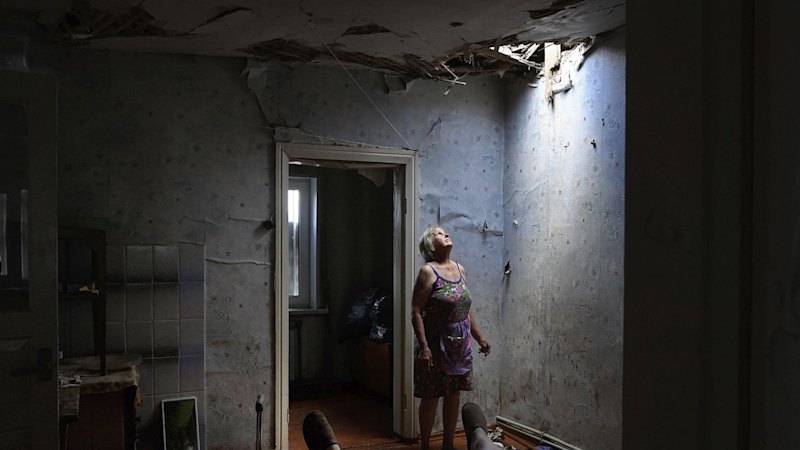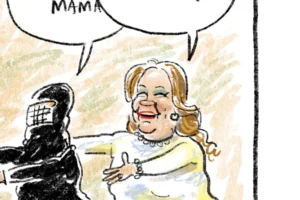
Normal text sizeLarger text sizeVery large text size
Every time I hear of another Russian attack in Ukraine, my thoughts always go to my friend and colleague Fedir and his wife, who live in Kyiv.
Are they ok? Was the drone strike anywhere near them? How many have been killed or wounded? Which parts of the city have been destroyed?
Before arriving to work in my role as the Herald’s chief photographer and knowing Fedir would not have slept, I send him a message to see if he’s OK.
This masthead’s Blood Oil series has highlighted the vast quantities of Russian-origin oil that have entered Australia since the war in Ukraine began and called for policy changes to help ensure Australians are not helping fund Vladimir Putin’s war machine against Ukraine.
Loading
The Australian-Ukrainian community, however, is still calling on the government to close all loopholes that allow this “blood oil” to flow into Australia and to join the European Union and Britain by vowing to stop any Russian energy products from entering via intermediaries.
As a photojournalist, over 23 years I have been sent on assignment to cover wars (Iraq, Syria, Afghanistan, Congo, Lebanon, Palestine’s West Bank and Ukraine) and document some of the most harrowing of situations from the Bali Bombings to Boxing Day Tsunami.
I have seen the devastation of war firsthand, seen the human toll and the destruction of communities, towns and cities. That is why it is so gut-wrenching to know that Australia as a country is complicit in helping fund Russia’s war efforts. Australia has a long history of supporting its allies. Now is the time to step up and close these “blood oil” loopholes.
I have been on assignment in Ukraine numerous times: in 2014 to cover the referendum, the downing of Flight MH17 and the Russian invasion. I returned in 2022 when Russia launched its full-scale war. Although I haven’t been back for several years, I know that every Russian attack – be it in the air or on the ground – brings immense devastation and destruction. Civilians are always the victims, with the war’s impact permeating every fibre of society.
MH17 wreckage, Ukraine 2014.Credit: Kate Geraghty
On the ground
This is what happens during a missile attack. If you are in a city, air raid sirens pierce the night and the Air Alarm app lights up your phone. You grab your bag that contains all your essential supplies. You’ve started sleeping fully dressed, so pulling on your shoes, you run to the basement or a nearby sub-station. Surrounded by neighbours you wait, bunkered down, hoping a missile does not hit as you monitor news sites and scan maps. If there is a strike close by, you may feel the earth shake or hear the explosion, knowing the destruction it will cause. You wait for the alert to signal the attack is over – or at least this wave of it. This may happen several times a night or day.
In the aftermath of an attack, emergency services search for the dead and injured, fires are extinguished, residents start to clean away the debris and board up windows. Others stand in shock. Clothing and personal belongings will be scattered everywhere, in the mud, strewn in trees or hanging from exposed balconies.
There is no way to calculate the immense mental and emotional toll on the civilian population. These are some of the people I met and took photographs of during my last visit to Ukraine in 2022.
For Zoya Shaposhnik, 67, her husband is too ill to evacuate. She must repair her home which was damaged in a missile strike in Krasnohorivka.
Zoya Shaposhnik stayed behind to care for her disabled husband, and has compassion for those suffering on both sides of the conflict.Credit: Kate Geraghty
Olekdsndr Fayizov, a civilian computer technician, shows me where Russian soldiers beat his head against the wall of a basement room in the Trostyanets railway station. He is still coming to terms with the trauma of what happened to him and dealing with the grief for the people he lost.
Olekdsndr Fayizov, a civilian computer technician demonstrates where Russian soldiers beat his head against the wall of a room used as a cell in the basement of the Trostyanets railway station in Ukraine.Credit: Kate Geraghty
Seven-year-old Volodymyr Baklanov lays unconscious with a bullet wound in Kharkiv hospital’s intensive care unit, unaware that his mother was shot dead next to him when Russian soldiers fired on their car. His younger brother sleeps in the hospital basement to shelter from the daily attacks.
Volodymyr Baklanov aged 7 years old recovering in intensive care from a bullet wound at Kharkiv.Credit: KATE GERAGHTY
Yekaterina Volkova was pulled from a burning nine-storey apartment building in Kyiv by emergency services. She has a long painful road ahead as she recovers from her injuries.
Emergency services rescue Yekaterina Volkova from an apartment building in Kyiv that was hit by a missile attack.Credit: Kate Geraghty
Liudmyla Rudska, 64, wipes tears from her face as artillery fire is heard outside her apartment building, which was first shelled in 2016, in the frontline town of Avdiyivka. She has lived through the past eight years of war and never thought the fighting would tear apart her country. She is fearful for the nation’s children who have grown up surrounded by war.
Sittting in her apartment in Avdiyivka and unable to leave, Liudmyla Rudska, 64, listens to artillery outside and wipes tears from her face when she recounts the impact of living on the contact line for the past eight years.Credit: Kate Geraghty
Since Russia launched its full-scale invasion of Ukraine in February 2022, 14,534 Ukraine civilians, including 745 children, have been killed, according to the Office of the United Nations High Commissioner for Human Rights (OHCHR).
For now I continue to check-in with my friends living in the midst of war. Knowing Fedir is safe for now, I end our conversation as I always do: “Hope your skies are quiet tonight”.
Kate Geraghty is a Gold Walkley Award-winning journalist and the Herald’s chief photographer.





